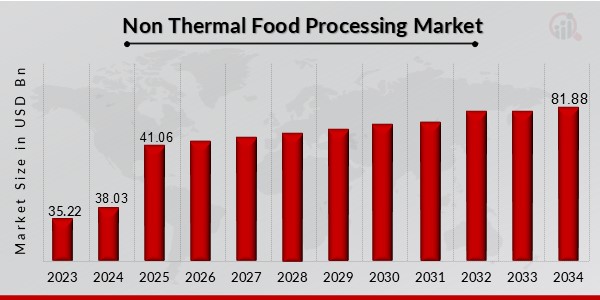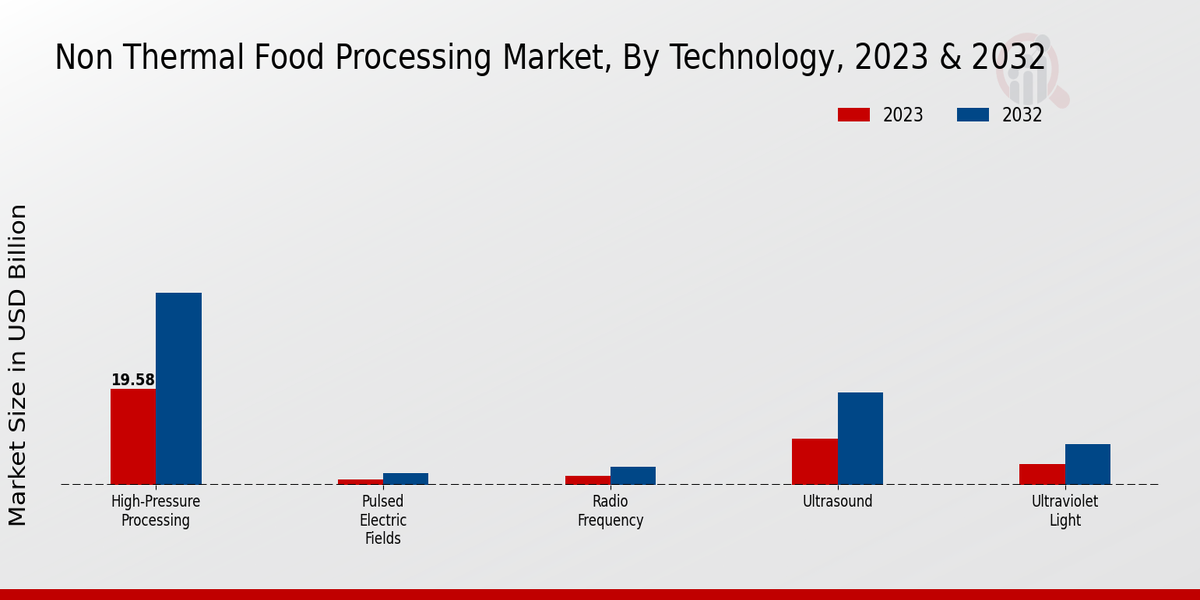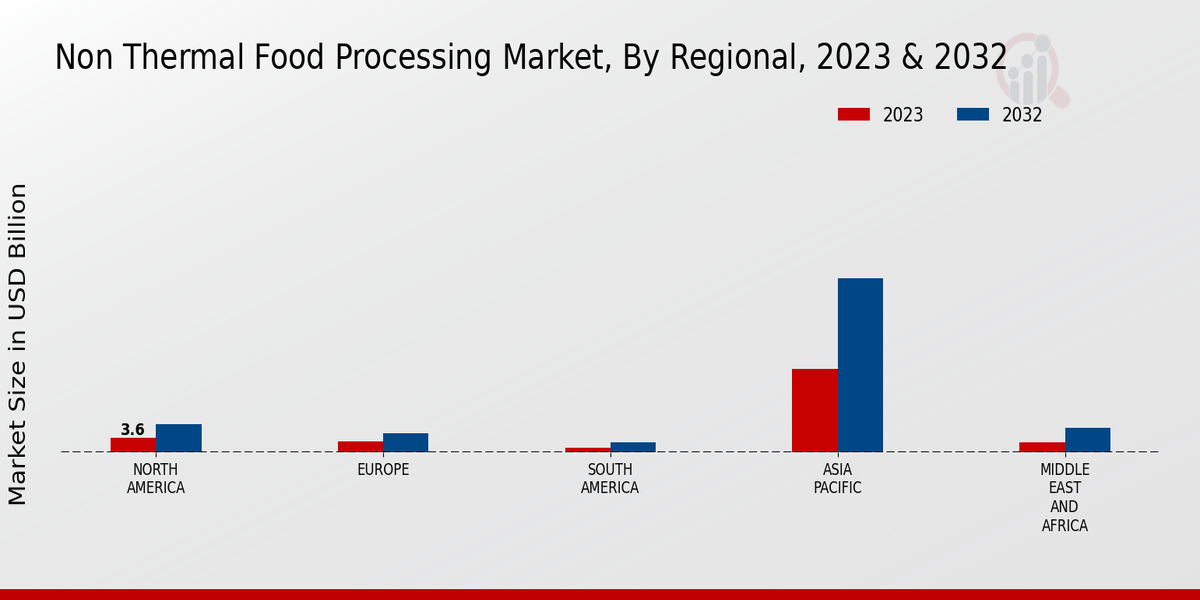Global Non Thermal Food Processing Market Overview
Non Thermal Food Processing Market Size was estimated at 38.03 (USD Billion) in 2024. The Non Thermal Food Processing Industry is expected to grow from 41.06(USD Billion) in 2025 to 81.88(USD Billion) by 2034. The Non Thermal Food Processing Market CAGR (growth rate) is expected to be around 8.0% during the forecast period (2025 - 2034).

Source: Primary Research, Secondary Research, MRFR Database and Analyst Review
Key Non Thermal Food Processing Market Trends Highlighted
Key Market Drivers
Increase in demand for minimally processed, nutrient-dense food products, awareness of the safety and health advantages of light food processing, and increased food safety regulations by the government.
Opportunities that shall be explored or seized
The growing importance of online channels for food sales distribution, tackling the unmet need for convenience foods in developing countries, and utilization of new technologies, mainly artificial intelligence and machine learning, for process improvement.
Trends in Recent Times
New emerging non thermal biotechnologies, including high-pressure processing (HPP), pulsed electric field (PEF), ultrasound, etc., emerging interest in sustainability and the environment, and rise in consumers want clean label products that do not use preservatives and additives.
Non Thermal Food Processing Market Drivers
Increasing Demand for Minimally Processed Foods
One of the key drivers of the Non Thermal Food Processing Market Industry is the rapidly increasing consumer demand for minimally processed fresh and natural foods. As consumers become better informed of the health benefits of minimally processed foods, regarded as such due to the fact they are not thermally processed, they request more such foods. Non thermal food processing technologies, such as high-pressure processing and pulsed electric fields, are used to meet such needs.They allow food manufacturers and suppliers to produce minimally processed foods that have the same nutritional value, freshness, and flavor, which also explains the significant demand for non thermal food processing equipment and services.
Rising Popularity of Ready-to-Eat Meals
Another growth driver of the Non Thermal Food Processing Market Industry is the increasing popularity of ready-to-eat meals. Such meals as salads, sandwiches, and entrees require less time spent on their heating or preparation. Non thermal food processing technologies help to ensure the required shelf life of ready-to-eat meals without affecting their quality and safety. HPP and PEF are used to produce ready-to-eat meals that are safe and convenient for keeping pace with the growing tendency towards consuming meals on the go.
Stringent Food Safety Regulations
Additionally, the uptake of non thermal food processing technologies is promoted by the implementation of stringent food safety requirements by a number of governmental agencies across the globe to ensure the quality and safety of food products. Thus, food processing technologies provide a number of benefits to ensure this. For example, HPP can eliminate pathogenic microorganisms, including Salmonella, E. coli, and Listeria, and it does not result in the loss of the biological content of food.Therefore, today, a growing number of food manufacturers apply non thermal food processing technologies to ensure the safety of their products since these comply with food safety requirements.
Non Thermal Food Processing Market Segment Insights
Non Thermal Food Processing Market Technology Insights
Non Thermal Food Processing Market by Technology “ The Non Thermal Food Processing Market is segmented by Technology into High-Pressure Processing, Pulsed Electric Fields, Radio Frequency, Ultrasound, and Ultraviolet Light. Among these, High-Pressure Processing technology held the largest market share in 2023, and is projected to continue its dominance throughout the forecast period. High-Pressure Processing involves subjecting food to extremely high pressure, typically ranging from 100 to 1000 MPa, for a short duration, resulting in the inactivation of microorganisms and enzymes without significantly altering the food’s nutritional value or sensory attributes.Pulsed Electric Fields technology, on the other hand, utilizes short, high-voltage electrical pulses to permeabilize microbial cell membranes, leading to cell death and inactivation. Radio Frequency technology employs electromagnetic radiation to generate heat within the food, achieving microbial inactivation and extending shelf life. Ultrasound technology utilizes high-frequency sound waves to create cavitation bubbles that disrupt microbial cell membranes and promote inactivation. Ultraviolet Light technology involves exposing food to ultraviolet radiation, primarily at wavelengths of 254 nm, to induce lethal effects on microorganisms.This technology is particularly effective against surface contaminants and is widely used in the disinfection of food contact surfaces and packaging materials. The Non Thermal Food Processing Market is driven by increasing consumer demand for minimally processed, fresh-like food products with extended shelf life. Non thermal food processing technologies offer a means to achieve these attributes without compromising food safety or quality. The growing adoption of these technologies across various food sectors, including dairy, meat, seafood, fruits, and vegetables, is contributing to market growth.Additionally, government regulations and industry initiatives aimed at ensuring food safety and reducing foodborne illnesses are further propelling the adoption of non thermal food processing technologies.”.

Source: Primary Research, Secondary Research, MRFR Database and Analyst Review
Non Thermal Food Processing Market Application Insights
The Non Thermal Food Processing Market is expected to reach USD 35.1 billion by 2024, exhibiting a CAGR of 8.1% during the forecast period. The increasing demand for minimally processed and healthy food products is driving the growth of the market. The application segment of the Non Thermal Food Processing Market is classified into fruits and vegetables, meat and poultry, dairy products, seafood, and beverages. Among these, the fruits and vegetables segment is expected to hold the largest market share during the forecast period due to the growing demand for fresh and minimally processed fruits and vegetables.The meat and poultry segment is also expected to witness significant growth due to the increasing demand for processed meat products. The dairy products segment is expected to grow steadily due to the increasing demand for dairy products such as yogurt, cheese, and milk. The seafood segment is also expected to grow due to the increasing demand for processed seafood products such as canned fish and smoked salmon. The beverages segment is expected to grow due to the increasing demand for processed beverages such as juices, soft drinks, and energy drinks.
Non Thermal Food Processing Market Processing Type Insights
The Non Thermal Food Processing Market is segmented by processing type into commercial scale, industrial scale, and laboratory scale. The commercial scale segment is expected to account for the largest share of the market in 2023, and is projected to grow at a CAGR of 7.5% from 2024 to 2032. The industrial scale segment is expected to grow at a CAGR of 8.1% from 2024 to 2032, and the laboratory scale segment is expected to grow at a CAGR of 9.2% from 2024 to 2032. The growth of the commercial scale segment is attributed to the increasing demand for non thermal food processing technologies in the food and beverage industry.Non thermal food processing technologies offer several advantages over traditional thermal processing methods, such as reduced energy consumption, improved product quality, and extended shelf life. The industrial scale segment is expected to grow due to the increasing adoption of non thermal food processing technologies in the pharmaceutical and cosmetics industries. The laboratory scale segment is expected to grow due to the increasing use of non thermal food processing technologies for research and development purposes.
Non Thermal Food Processing Market End User Insights
The end user segment of the Non Thermal Food Processing Market is categorized into Food and Beverage Manufacturers, Research Institutions, and Government Agencies. Food and Beverage Manufacturers account for the largest share of the market, driven by the increasing demand for safe and high-quality food products. Research Institutions are also significant contributors to the market, as they conduct research and development on new non thermal food processing technologies. Government Agencies play a crucial role in regulating the non thermal food processing industry, ensuring the safety and efficacy of these technologies.
Non Thermal Food Processing Market Equipment Type Insights
The Non Thermal Food Processing Market is segmented by Equipment Type into Stand-Alone Units, Integrated Systems, and Sensors and Monitoring Systems. Among these segments, Stand-Alone Units held the largest market share in 2023, accounting for around 45.0% of the Non Thermal Food Processing Market revenue. The growth of this segment can be attributed to the increasing adoption of standalone non thermal food processing technologies, such as pulsed electric fields (PEF) and high-pressure processing (HPP), by food and beverage manufacturers.Integrated Systems, which combine multiple non thermal processing technologies into a single system, are expected to witness the highest growth rate during the forecast period, owing to their ability to provide greater process efficiency and control. Sensors and Monitoring Systems play a crucial role in ensuring the safety and quality of non-thermally processed foods, and their demand is expected to rise in line with the growing adoption of non thermal food processing technologies.
Non Thermal Food Processing Market Regional Insights
The Non Thermal Food Processing Market is segmented into North America, Europe, Asia Pacific, South America, and the Middle East and Africa. North America is expected to hold the largest market share due to the presence of major food processing companies and the increasing demand for processed foods. Europe is also a significant market for non thermal food processing, with a growing trend towards healthy and convenient food products. The Asia Pacific region is expected to witness the fastest growth in the coming years, driven by the increasing population and the rising demand for processed foods.South America and the Middle East and Africa are also expected to show steady growth in the non thermal food processing market.

Source: Primary Research, Secondary Research, MRFR Database and Analyst Review
Non Thermal Food Processing Market Key Players And Competitive Insights
Leading players in the non thermal food processing market are making constant efforts to achieve a competitive advantage by investing in research and development activities, expanding product capabilities, and collaborating with other firms. Top companies operating in the Non Thermal Food Processing Market are concentrating on developing innovative technologies that assist in augmenting the quality, safety, and shelf life of food products. The development of the non thermal food processing market is largely guided by the growing consumer preference for minimally processed foods and natural products, as well as concerns regarding food safety. The non thermal food processing market is expected to continue to be dynamic, with new companies and existing firms jostling for market share.
One of the major players in the Non Thermal Food Processing Market is Barry Callebaut.’ The company offers different non thermal food processing technologies, including HPP, PEF, and cold plasma. Barry Callebaut’s HPP technology is used to enhance the shelf life of food items by inactivating microorganisms and enzymes present in the food item. HPP technology has been developed by Barry Callebaut to counter the high pressure during the processing of food items. PEF technology is another form of non thermal food processing technology that was developed by Barry Callebaut to enhance the texture and quality of food mediums. Cold plasma technology, on the other hand, is offered by the company to remove contamination from food products and enhance their safety.
Another company that is present in the Non Thermal Food Processing Market is Tetra Pak. This company has been offering different non thermal food processing technologies such as aseptic packaging, and UHT and microwave heating. Aseptic packaging helps enhance the shelf life of food products by preventing the entry of microorganisms. UHT processing technology offered by the company helps kill the microorganisms and enzymes present in the food medium. Microwave heating is used to quickly and uniformly heat food products.
Key Companies in the Non Thermal Food Processing Market Include
Non Thermal Food Processing Market Industry Developments
The Non Thermal Food Processing Market is projected to grow from USD 31.24 billion in 2023 to USD 65.0 billion by 2032, exhibiting a CAGR of 7.97% during the forecast period. Increasing consumer demand for minimally processed and nutritious food products, coupled with growing awareness regarding the benefits of non thermal processing techniques, is driving market growth.Recent news developments in the market include the launch of new non thermal processing technologies, such as high-pressure processing (HPP) and pulsed electric fields (PEF), which offer improved product quality and extended shelf life. Strategic partnerships and collaborations between market players are also shaping the competitive landscape, with companies investing in research and development to enhance their product offerings.
Non Thermal Food Processing Market Segmentation Insights
-
Non Thermal Food Processing Market Technology Outlook
-
High-Pressure Processing
-
Pulsed Electric Fields
-
Radio Frequency
-
Ultrasound
-
Ultraviolet Light
-
Non Thermal Food Processing Market Application Outlook
-
Fruits and Vegetables
-
Meat and Poultry
-
Dairy Products
-
Seafood
-
Beverages
-
Non Thermal Food Processing Market Processing Type Outlook
-
Commercial Scale
-
Industrial Scale
-
Laboratory Scale
-
Non Thermal Food Processing Market End User Outlook
-
Non Thermal Food Processing Market Equipment Type Outlook
-
Non Thermal Food Processing Market Regional Outlook
-
North America
-
Europe
-
South America
-
Asia Pacific
-
Middle East and Africa
| Report Attribute/Metric |
Details |
| Market Size 2024 |
38.03(USD Billion) |
| Market Size 2025 |
41.06(USD Billion) |
| Market Size 2034 |
81.88(USD Billion) |
| Compound Annual Growth Rate (CAGR) |
8.0% (2025 - 2034) |
| Report Coverage |
Revenue Forecast, Competitive Landscape, Growth Factors, and Trends |
| Base Year |
2023 |
| Market Forecast Period |
2025 - 2034 |
| Historical Data |
2019 - 2023 |
| Market Forecast Units |
USD Billion |
| Key Companies Profiled |
SPX Flow, Schneider Electric, Rockwell Automation, Ecolab, Tetra Pak, GEA Group, Emerson Electric, Alfa Laval, Siemens AG, 3M, ABB Ltd., Honeywell International Inc., Yokogawa Electric Corporation, Danfoss, Johnson Controls |
| Segments Covered |
Technology, Application, Processing Type, End User, Equipment Type, Regional |
| Key Market Opportunities |
Growing health consciousness, increasing demand for minimally processed foods, technological advancements, regulatory support and expanding applications in various industries |
| Key Market Dynamics |
Increasing safety concerns High demand for convenience food Rising trend of plant-based food Scaling application in dairy products Growing awareness of foodborne illness |
| Countries Covered |
North America, Europe, APAC, South America, MEA |
Frequently Asked Questions (FAQ) :
The Non Thermal Food Processing Market is expected to reach a market size of USD 41.06 billion in 2025.
The Non Thermal Food Processing Market is projected to grow at a CAGR of 8.0% from 2025 to 2034.
The key regions in the Non Thermal Food Processing Market are North America, Europe, Asia-Pacific, and Rest of the World.
The major applications of Non Thermal Food Processing include food preservation, food safety, and food quality improvement.
The key competitors in the Non Thermal Food Processing Market include JBT Corporation, Alfa Laval, Tetra Pak, and GEA Group.
The key trends in the Non Thermal Food Processing Market include the increasing demand for minimally processed foods, the growing popularity of e-commerce, and the rising awareness of food safety.
The challenges facing the Non Thermal Food Processing Market include the high cost of equipment, the lack of technical expertise, and the regulatory hurdles.
The future outlook of the Non Thermal Food Processing Market is positive, driven by the growing demand for minimally processed foods and the increasing awareness of food safety.
Yes, the Non Thermal Food Processing Market is expected to grow significantly in the Asia-Pacific region due to the rising demand for minimally processed foods and the growing population.
The Non Thermal Food Processing Market is expected to reach a market size of USD 81.88 billion in 2034.

















